|
Kaaknasoon
(กากนาสูร) Thai.
Name of a character from the Ramakien, a female giant belonging to the
entourage of Totsakan, who instructed her to harm a reusi, who lived in
the forest. She changed herself into a large crow and flew to his
hermitage, which she completely destroyed whilst ferociously pecking at
the hermit. The hermit then went to see Totsarot and told him what had
happened. Totsarot then sent Phra Ram and Phra Lak to help the hermit
and when Kaaknasoon returned after seven days, she was shot and killed
by an arrow.

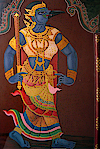
kaangkok sawan (คางคกสวรรค์)
Thai. 'Heavenly toad'. Name of
an auspicious animal from Chinese mythology. Also called kop sahm kha
which means 'three-legged frog'. It is often portrayed with red eyes and
flared nostrils, sitting on a pile of traditional Chinese money, often
with a string of ancient Chinese coins on each side of its body. It has
the power to attract fortune and richness as well as to protect
property, but needs to be activated by placing a coin in its mouth. It
is said that the heavenly toad lives on the moon and its powers increase
visibly during a lunar eclipse. According to a Chinese legend there once
was a lady who was the wife of one of the Eight Immortals, who heaven
had bestowed with the amrita, the elixir of immortality. This lady loved
gold and money but was still a mortal. Thus, she stole the amrita but
got caught and punished for it by heaven. She was cursed and changed
into a toad with only three legs, and banished to, or vanished into, the
moon (leaped into it, and escaped). It is believed that whoever finds
the three-legged frog will also find a pile of silver and gold, as it
still is its nature to treasure these things. Hence the three-legged
frog became the auspicious animal from heaven that drives away evil and
assists in bringing great wealth to peoples homes. It needs to be placed
facing the entrance of a home or shop to invite money in, but at night
it should be turned backwards to prevent the daytime earnings from
disappearing again. It is the traditional pet of the immortal Liu Hai,
an informal Taoist god of wealth, whose toad would convey him to any
place he wishes to go, but occasionally it would escape down a well, and
he would then lure it out with a line baited with gold coins.
Occasionally, it is portrayed with Nakula, one of the 18 arahats. In
Chinese it is called chanchu, with chan also meaning 'moon' in both
Chinese and Thai. In English it is also referred to as Lucky Money Toad,
Moon Frog and Three-legged Money Frog.


Kadru (कद्रू)
Sanskrit. Name of the daughter
of Daksha, wife of Kasyapa and mother of the nagas in the Mahabharata,
but in the Ramayana she is described as being the daughter of Kasyapa
and Krodhavasa, who is also a daughter of Daksha.

Kailasa (कैलास)
Sanskrit. A mountain in the
Himalayas, the dwelling place of Shiva and Parvati. In Thai Krailaat and
in Sanskrit also called Kailash.

kala
(कला)
1. Sanskrit. Term used to
express time and energy, death and creation, as well as the destruction
of the universe. Personified as Mahakala, a form of Shiva, and as Kali
or Mahakali, a form of his consort Devi. Both represent the terrifying
destructive aspects of time. The Thai word for time (kaan, กาล) is
derived from it. Pronunciation is ka-lah.

2. In Thailand, Cambodia and
Indonesia, term for kirtimukha. Pronunciation is ka-lah.

kala
(काला)
Sanskrit-Pali. 'Black'. The
name Kali is derived from it and it also occurs in the name of the Thai
province Kalasin, which means 'black water' or 'black river'.
Pronunciation is kah-lah.

kalachakra (กาลจักร)
Sanskrit-Thai. 'Wheel of Time'.
Associated with the dance of time and eternity performed by Shiva.

Kalewin (กเลวิน)
The reusi who paid homage to
the newborn prince Siddhartha and to whom the infant showed his first
miracle by placing himself on the turban of the sage. Other texts,
however, mention a hermit with the name Asita. In Sanskrit Kaladevaila.


Kali
(काली)
1. Sanskrit. In Vedic times the
name meant 'the black one' and was associated with Agni, the god of
fire, who had seven tongues with which he licked the offerings of
butter. Of these seven tongues Kali was the black, terrifying tongue.

2. Sanskrit. 'Black goddess'.
The horrifying form of Devi, the consort of Shiva. She is sometimes
depicted with a terrifying face with tusks and smeared with blood, and
four or more arms, one of which holds a weapon and another sometimes the
head of a giant dripping with blood. Her ornaments include snakes,
skulls, and figures of children. She is a form of Durga.


3. Sanskrit. Fourth and last of
the four yugas, and the present time cycle according to Indian
cosmology. For more see Kali Yuga.

Kalika (कालिक, กาลิกะ)
Sanskrit-Thai. 'Relating to
time', akin to the Thai word kaan (กาล). Name of one of the eighteen
arahats, who is usually depicted sitting on an elephant whilst studying
a scroll. Though some sources state that he formerly was a mahout, the
elephant, an animal of immense strength, endurance and perseverance, is
more likely an allegory for the power of Buddhism, whereas the scroll
represents the sutra. In Chinese he is known as the luohan Qi Xiang,
literally 'To Mount an Elephant'. In English he is referred to as the
Elephant-Riding Lohan or the Dust Cleaning Arhat, indicating the dusty
mind that needs to be cleaned and akin to Chudapanthaka, the Door
Watching Arhat, who sweeps dusty floors as a cleaning meditation.


Kaliya (कालिया)
The serpent king with five
heads which was subdued by Krishna, when he was a mere child. It lived
in a whirlpool of the river Yamuna, polluting the neighborhood with its
poison, until it was removed by Krishna. This scene is often depicted in
art as the young Krishna dancing on the head of the snake.

Kali Yuga (कलीयुग)
Sanskrit. The present era or
time period and the most depraved of the four yugas, the cycles of
creation. This cycle began in 3,102 BC and will last 432,000 years,
according to Brahman beliefs.

Kalkin (कल्किन्)
The tenth, still to appear
avatara of Vishnu in the form of a white horse. Riding this horse he
will destroy all evil with a blazing sword and restore the innocence in
the world, at the end of the present Kali era. Sometimes called Kalki.

kalpa
(कल्प)
Sanskrit. The duration of a
cosmic period equaling 4,320,000,000 years for mortals, but just one day
and night for Brahma.

kalyanamandapa (कल्याणमण्डप)
Sanskrit. 'Mondop of good
fortune' or 'auspicious mondop'. A hypostyle hall used for the symbolic
marriage of the temple deity.

kama
(काम)
Sanskrit. 'Love' or 'desire'.
In Hinduism personified by Kama. In Buddhism kama refers to both the
senses and visible phenomena.

Kama
(काम)
The god of love and desire,
portrayed as the most handsome of all gods. He has wings and carries a
bow that is made of sugarcane with a string of honeybees and arrows
decorated with fragrant flowers. His mount is a parrot and the apsaras
are his servants. He is also known as Manmatha and Kamadeva.

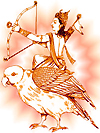
Kambuja
Khmer. Name of the ancient
Khmer people. They are the supposed descendants of the Hindu sage Kambu
Svayambhuva, their eponymous ancestor. An ancient legend tells that
Shiva gave him the apsara Mera, a celestial nymph, as his bride. From
their names the word Khmer is said to have derived, i.e. Kambu and Mera
became Kamera, later to be pronounced Khmer. A royal lineage came forth
from this couple and the name Kambuja means 'born from Kambu'. In
another legend, it is told that the father of Mera was a dragon king who
ruled over a watery kingdom. When is daughter was to marry an Indian
Brahmin named Kaundinya (another name for Kambu) and in need of a dowry,
he drank all the water of his kingdom in order to provide his son-in-law
with land. That land, is told, was named Kambuja. This is reminiscent of
a Thai legend in which a phayanaag, the chief of the nagas, drank all
the water of the world to provide his son-in-law with land, but was
ordered by Vishnu to return it all and was squeezed until he had
expelled all the water he had consumed. These stories are perhaps
inspired by Cambodia's Tonlé Sap lake, the largest freshwater lake in
Southeast Asia, which dimensions swell and shrink up to five times its
original size, depending on the seasonal monsoons and the flow of the
Tonlé Sap river that in the Southeast converges with the Mekhong river.
In the rainy season, when the level of the Mekhong rises rapidly, it
reverses the natural flow of the Tonlé Sap river, causing it to flow
upstream, into the lake. The name Kambuja is still in use in Cambodia
today.

Kanaka Bharadvaja
(कनकभारद्वाज, กนกภารัทวาช)
Sanskrit-Thai. 'Golden
Bharadvaja'. Name of one of the eighteen arahats, who was a Buddhist
mendicant monk known for begging with his alms bowl and eyes upraised,
accepting food without shame. This is contrary to normal practice, as
monastic precepts prohibit monks to eyeball anyone at any given time and
monks on bintabaat are instructed to submissively bow their heads toward
the ground when accepting food. He thus represents one who can receive
gifts graciously. He is usually portrayed standing on one foot with one
knee pulled up and both hands stretched out in the air, holding a small
alms bowl. It is assumed that as joy descends from heaven, he raises the
bowl to receive happiness. In paintings he is sometimes pictured with a
small disciple at his side. In Chinese he is known as the luohan Tuo Bo,
literally 'To Hold An Alms Bowl Up With The Palm'. In English he is
referred to as the Raised Bowl Lohan or Alms Holding Arhat.

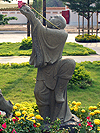
Kanaka Vatsa (कनकवत्स,
กนกวัจฉะ)
Sanskrit-Thai. 'Golden Calf'.
Name of one of the eighteen arahats, who was a well-known public speaker
and debater of the Buddhist doctrines and famous for his sermons on
happiness which he described as experienced through the five senses, in
contract to bliss which defined he as joy not coming from the five
senses, but from deep within, like a feeling in ones his heart and not
being subject to changes on the outside, it could be sustained
indefinitely. He often smiled during debates and is sometimes portrayed
banging cymbals in joy. In Thai his name is pronounced Kanakawatcha, but
he is also known as Khayaket. In Chinese he is known as the luohan Xi
Qing (喜庆, or in traditional Chinese: 喜慶), literally 'To Be Happy and
Celebrate'. In English he is referred to as the Happy Lohan or Jolly
Arhat. Also written Kanakavatsa.

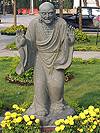
Kan
Khwan
Kayang. Name of a traditional
religion as practiced by the Kayang (Kayan) people of Burma and Northern
Thailand. Its doctrine asserts that the world was created by the eternal
creator Phu Kabukathin assisted by two other deities, that is Ti who
created the earth and La Taon who created man and the animals. Kan Khwan
belief trusts that all components of the Universe are linked together by
a giant spider's web, embracing the earth, the moon and all the stars.
In the beginning the land of the earth was fluid, so, the god Phu
Kabukathin planted a small post in the ground. As the post grew the
earth also grew into seven outer and inner layers and it became firm.
The post was named Kan Thein Bo, meaning 'the means of formation of
earth' and is today an important part of their religious worship. Kan
Khwan belief is in practice since the Kayang people emigrated from
Mongolia during the Bronze Age.

Kanthaka (कण्टक)
Sanskrit. 'Rebel'. The
snow-white horse of prince Siddhartha, born on the same day as its
master. After carrying the prince away from the palace during the Great
Departure, the horse died of sorrow. Also Kantaka.


Kanthakumara (कण्टकुमार)
Sanskrit. 'Rebel prince'. Son
of Uma or Devi, the shakti or consort of Shiva. Also Subramaniam and in
Thai usually called Phra Kanthakuman. Sometimes transcribed Kantakumara.

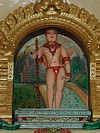
Kan
Thein Bo
Kayang. 'The means of formation
of earth'. Name of a kind of totempole worshipped by the Kayang people
of Burma and Northern Thailand. It is said that after the creation of
the earth all land was fluid and Phu Kabukathin, the eternal creator,
therefore planted a small post in the ground, enabling earth to grow and
the land to become firm. This eventually enabled the Kayang people to
settle down. Every year between March and April, the Kayang erect a new
pole, if possible, made from the eugenia, the first tree said to ever
been created. The pole comprises of the sun, at its peak; the sanctuary,
a place where the deities reside; and the streamer, a ladder that
connects earth with heaven, with at the top a spider's web that humans
need to pass to go to heaven. See also Kan Khwan.

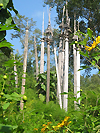
Kao Suriya
In the Ramakien the wife of the
mythological king Totsarot of Ayutthaya, and mother of Rama.

Kapilavatthu
Sanskrit. The empire in
nowadays southern Nepal (formerly India) where king Suddhodana, the
father of the historical Buddha ruled, and consequently the birthplace
of prince Siddhartha. In Pali called Kapilavasthu.

karawak
Sanskrit. A mythical creature
half human and half bird. See also Garuda.

karma
(कर्म)
Sanskrit. The law of cause and
effect, in which one's present state is the result of actions from the
past, either in this life or in former lives. Karma ends when one
attains nirvana and the cycle of death and rebirth is broken. Karma is
closely linked with samsara and transmigration.

Karttikeya (कार्तिकेय)
The god of war, leader of
Shiva's troops and usually considered to be the son of Shiva and Parvati.
He is often represented with six heads and six arms, holding a double
thunderbolt, a sword, a trident, and riding a mayura. In art from Champa
his mount is a rhinoceros. In South India he is known as Subrahmanya. As
the son of Shiva he is named Kumara, meaning 'prince'. He is also known
by the name Skanda. Also transcribed Kartikeya.

Kashyapa (कश्यप)
See Kasyapa.

Kassapa
1. A buddha of the past, a
precursor of the historical Buddha.

2. The monk who succeeded the
Buddha as leader of the Sangha. In mural paintings usually portrayed as
an old man accompanied by the young monk Ananda, the Buddha's nephew and
his most important disciple. Also Maha Kassapa.

Kasyapa (कश्यप)
1. Sanskrit. Name of a rishi
who is the father of the devas, asuras, nagas and all humans. He has
several consorts, i.e. the thirteen daughters of Daksha, with whom he
had several offspring, e.g. Garuda and Aruna are his sons with his
consort Vinata, the apsaras are his children through Muni, the nagas are
his sons from Kadru, Agni and the Adityas are his sons by his wife Aditi,
etc. Also transcribed Kashyapa.

2. Sanskrit. Name of one of the
candidates for inclusion as the 17th or 18th arahat, especially when
referred to as Maha Kasyapa which is sometimes spelled Maha Kassapa. As
Maha Kasyapa the name may also refer to one of the four initial arahats,
whom the Budhha had asked to remain in the world to propagate the dhamma,
one for each of the four directions of the compass.

Kauravas (कौरव)
Descendants of the Lunar king
Kuru, a royal family branch in the Indian epos Mahabharata. See also
Pandava.

kaustubha
A magical gem that surfaced
during the churning of the Ocean of Milk and is worn on the chest by
both Vishnu and Krishna.

Ketu
(เกตุ)
1. Sanskrit-Thai. The lower
part of Rahu that represents his tail and is considered the
personification of comets and meteorites, whilst the upper part of Rahu
travels through the universe in a chariot pulled by eight black horses.
The demon Rahu was cut in two by Vishnu using his chakra for secretly
lining up among the gods and receiving a portion of the amrita. Ketu is
one of the nine gods worshipped in the phra prajam wan system of the
Hindus, lined up in the northwestern corner, facing South. The Rahu name
also appears in the Buddhist Phra prajam wan geut system as the pahng
pah leh laai Buddha pose, corresponding with Wednesday after sunset.


2. Sanskrit-Thai. Name of the planet Neptune.

Ketumati
Sanskrit. The earthly paradise
that the bodhisattva Maitreya will preside over when he descends from
Tushita heaven as the future Buddha.

khakkhara (खक्खर)
Sanskrit. Name for a ringed
staff held by certain arahats, monks and bodhisattvas in Mahayana
Buddhism. It is meant to inform people of their presence through the
jingling sound caused by the rings and in order to seek alms, as well as
to warn small and crawling creatures of their approach, so as to avoid
stepping on them. By announcing their arrival in this way they avoid
speak unnecessarily. It is also used by Shaolin warrior monks as a
weapon and in prayer, e.g. by the abbot of a Chinese temple usually
wields the staff during grand ceremonies, striking the ground three
times to symbolize the breaking of ignorance. The khakkhara consist of a
usually thin, wooden staff capped with metal loops and rings which are
either four, six or twelve in number, indicating the Four Noble Truths,
the Six Paramitas or the Twelve Nidanas, respectively. Occasionally, the
rings may be double. The bodhisattva Ksitigarbha is usually depicted
carrying a khakkhara, which he also uses to force open the gates of
hell, and the arahat Chudapanthaka was given one by the Buddha, to stop
him from knocking on doors when begging for alms. In Chinese called xi
zhang, literally 'thin cane' or 'thin walking stick', but also
'bestowing staff'. It is sometimes referred to as a Buddhist beggar's
staff.

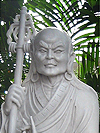
Khom dam din (ขอมดำดิน)
Thai-Khmer. 'Ground submerging
Cambodian'. Name for the Khmer envoy who was sent to arrest Phra Ruang.
According to legend, he was able to travel underground by using magic
powers. However, when he emerged to deliver the Khmer King's message,
legend says he was turned into stone by Phra Ruang.

kilen (กิเลน)
Name for a creature of Chinese
fables. In Chinese it is called khiling, a compound word consisting of
the prefix khi and the suffix ling. Khi stands for a male kilen, whereas
ling represents a female kilen. They are therefore often depicted in
pair. In traditional iconography the kilen has a scaled, dear-like body,
with on its back short curly manes and a bushy tail; legs with hoofs
like those of a horse; and the head of a dragon with one dear-like horn.
But in popular iconography it usually depicted with a scaled body with
long manes on its back; a bushy tail; legs with the paws of a wild dog;
the head of a dragon, but somewhat resembling that of a lion; and two
dear-like horns. Besides this other varieties with slightly different
features may also occur. Sometimes transcribed as kilin, kylin, kirin or
qilin.

%20from%20Chinese%20mythology_small.jpg)
kiletsamaan (กิเลสมาร)
Thai. Name of a demon who bars
the way to bliss. The name is formed by merging the term kilet, i.e. an
unwholesome thought that causes unhappiness and barring the way to
bliss, and the name Maan, the Thai name for Mara.

Kinnara (किन्नर)
Sanskrit. Originally a mythical
creature with a human body and the head of a horse, or the other way
around. In later times it became a combination of a bird and a man (Kinnara)
or woman (Kinnari), with a human torso and head, and the wings and legs
of a bird. In India the Kinnaras were a subgroup of the gandharvas. It
is similar to a Theppaksi but its lower arms have a winged section with
feathers, whereas its counterpart does not.

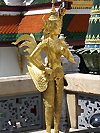
Kinnon (กินนร)
Thai. Name for a race of beings
that are half-bird half-human. The male species is called Kinnaburut,
the female species Kinnari or Kinnarin.

kirtimukha (कीर्तिमुख)
Sanskrit. 'Face of glory'.
Indian term for a mask-like creature above some temple doors, usually
represented as a face with two horns, round bulbous eyes, the nose of a
human or lion, a wide mouth with teeth, often without a lower jaw. In
both Buddhist and Hindu mythology this creature is intended to drive
away evil and protect the devout. In Thailand, Cambodia and Indonesia it
is called kala. In English also kala face.

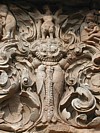
kodchasih (คชสีห์)
Thai name of a fabulous animal
from the Himaphan forest, similar to a lion but with a trunk and tusks
like an elephant. In Pali the cross between an elephant (gaja) and a
lion (singha) is called gajasingha, of which there are several types. It
is the symbol and logo of the Thai Ministry of Defense. Also transcribed
kotchasih.

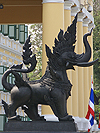
Kosala (कोशल)
The empire of king Dasharatha,
the father of Rama. Also transcribed Koshala.

Krailaat (ไกรลาศ)
Thai name for the mountain on
which the Hindu god Shiva dwells, in Sanskrit named Kailasa.

kratha thong daeng
(กระทะทองแดง)
Thai. Name for a large copper
kettle in which the Yommabaan in hell boil sinful people as a
punishment.

_small.jpg)
Krishna (कृष्ण)
Sanskrit. 'The dark one' or
'dark blue'. The eighth and most popular avatar of Vishnu, with a blue
complexion. He is first mentioned in the Mahabharata where he delivers
the world the Bhagavad Gita, a religious poem of great significance in
which he reveals himself as a supreme being. Although an avatar of
Vishnu, Krishna is worshipped as a god in his own right and is as such
the most celebrated god of the Hindu pantheon. He is often portrayed as
a young boy or a youthful prince playing the bansuri, a bamboo flute of
which he is a master.

_small.jpg)
Krita
(कृत)
Sanskrit. First of the four
yugas.

krodha (क्रोध)
Sanskrit. 'Anger'. A feature of
certain Buddhist and Hindu gods intended to fend off foes and protect
the devout. The Thai word kroht is derived from it.

Ksitigarbha (क्षितिगर्भ,
กษิติครรภ)
Sanskrit-Thai. 'Earth
Offspring' or 'Earth Womb'. Name of a bodhisattva who is regarded as the
bodhisattva of hell beings, due to his vow to postpone buddhahood, until
all hells are emptied. He is therefore sometimes referred to as the
Bodhisattva of the Great Vow. He is one of the four principal
bodhisattvas in Mahayana Buddhism, the others being Samantabhadra,
Manjushri and Avalokitesvara. He is usually depicted carrying a
khakkhara, a Buddhist beggar's staff which he uses to force open the
gates of hell, and a small bowl which is sometimes explained to be a
chintamani, a wishing jewel akin to the ruyi and mani-stones, or a
singing bowl. In Chinese known as Ti Tsang which translates as 'Earth
Storehouse', but is often called 'Earth Treasury'.

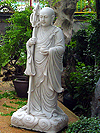
kuandao (关刀)
Chinese. 'Blade of Kuan'. Name
for a type of traditional Chinese weapon consisting of a heavy, serrated
blade on a 1.5 to 1.8 meter long pole. The shape of the deeply curved
blade somewhat resembles a human hand. It has a spike at the back and
usually also an indentation at the spike's upper base to catch an
opponent's weapon. It is a defense weapon rather than an offensive one.
Its purpose is to disarm an enemy and ward off his strikes rather than
to attack. To this end, a large sash or veil cloth is often attached at
the joint of the pole and blade, to confuse opponents. Also transcribed
guantao and kuantao, but properly called yan yue dao, literally 'falling
moon knife'. In literature it is often referred to as 'reclining moon
blade' or 'crescent blade' and when held by the Tiger General Kuan U it
is called the Green Dragon Crescent Blade, Qing Long Yan Yue Dao in
Chinese, since its blade is decorated with the motif of a dragon.
According to legend, Kuan U was the inventor of the kuandao, hence the
name, but there is no historical proof of this.

_small.jpg)
Kuan U (กวนอู)
Thai-Chinese name for Guan Yu
(AD 160–219), the Tiger General of Shu and blood brother of Liu Bei, the
warlord under whom he served during the late Eastern Han Dynasty. He was
a fearsome fighter, yet famous for his virtuousness and loyalty, a brave
and faithful warrior in the Romance of the Three Kingdoms. He is
posthumously worshipped as the deity who teaches righteousness and is
traditionally portrayed as a warrior with a red face and a long lush
beard. In ngiw, Chinese opera, the colour red represents loyalty and
righteousness. He is also often depicted in combat atop his horse Sek
Tao holding the Green Dragon Crescent Blade, a type of traditional
Chinese weapon, called kuandao and which consists of a heavy blade on a
long, usually wooden, pole. Kuan U has a fierce looking aide-de-camp who
is known as warlord Chou Tsang and a son named Kuan Ping. He is also
known as a Cai Shen, i.e. the Chinese warrior god of wealth and in
Buddhism he is identified with the bodhisattva Sangharama, the guardian
of the dharma.

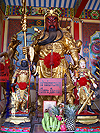
Kuan
Yin (觀音)
Chinese goddess of mercy, in
Japan known as Kwannon and in Thailand as Phra Mae Kwan Im. According to
legend Kuan Yin was born a princess, daughter of a Chinese emperor who
was not a Buddhist and was furious to see his daughter’s devotion to
Buddhism. Before her marriage, the princess freed several tortured
prisoners and escaped from the palace. Many oppressed people followed
her. When her father was gaining on them, a magic bridge appeared to
save the princess and her followers. Soon her father became seriously
ill and the doctor told her that the only cure included the arms and
eyes of a virgin. With appreciation for her father, the princess decided
to sacrifice herself, thus healing her father. With her willingness to
help those in misery, people came to worship her as the goddess of
mercy. As a lady, she is the female form of the male bodhisattva
Avalokitesvara, the personification of compassion, from Mahayana
Buddhism. As the female form of Avalokitesvara she also wears the
portrait of Amitabha in her headdress, and she is sometimes depicted
with several arms, like the Radiating Avalokitesvara, a representation
referred to as the thousand hands.

_small.jpg)
Kubera (कुबेर)
The god of wealth in both
Hinduism, Jainism and Mahayana Buddhism. He is a half-brother of Ravana
who defeated him and usurped his throne. He is often represented as a
obese figure carrying a money bag and a water jar, and accompanied by
seven treasures or a mongoose vomiting coins and jewels. He is guardian
of the North and in Hinduism rules over the yakshas and kinnaras who
guard his treasures. Also Kuvera. In Sanskrit Vaisravana and in the Thai
Ramakien called Kumphakan. Compare with Phra Sangkatjaai.

Kui
Xing (魁星)
Chinese. 'Chief star'. Name for
the god of examinations in Chinese mythology. Kui Xing was a brilliant
student and outstanding scholar, but was awfully deformed. After passing
the Imperial examinations with remarkable success he was supposed to
have received the golden rose from the emperor, but due to his
disfigured appearance the emperor was so shocked that he dropped the
golden rose and it broke into pieces, or according to another source,
was so repulsed that he refused to give it to him. In despair Kui Xing
then either drowned himself and his spirit drifted to heaven, or
according to another source, he fell or jumped into the water from a
boat and was rescued by a sea dragon that escorted him up into heaven,
where he became the deity of scholars who took imperial examinations, as
related by both sources. He is often depicted standing on one leg and
holding up a Chinese writing brush. Chinese has a number of words
pronounced the same but with different ideographs which has led to a
combination of meanings, e.g. the word Kui can also be translated as
'one-legged monster'. It is suggested that his name before deification
was Zhong Kui (Chung K'uei), although this might also be another god, as
mythological characters with similar backgrounds or service functions
are sometimes blended together and are spoken of as if they are a single
entity. It is therefore unclear if Chung K'uei actually ís Kui Xing or
if he is yet another character from Chinese mythology. Also transcribed
K'uei Hsing.


kumaanthong (กุมารทอง)
Thai. 'Golden prince'. Often
seen figurines of a young prince. The most popular one being a figurine
of the prince holding a purse in one hand while making a kwak gesture
with the other. The figurine is said to bring good luck and fortune. The
feminine form is called kumarithong.


Kumara (कुमार)
Sanskrit. 'Prince'. A name of
the god of war Skanda, as the son of Shiva.

Kumari (कुमारी)
Sanskrit. 'The maiden'. A name
of Parvati, before she became the consort of Shiva.

Kumbhakarna (कुम्भकर्ण)
Sanskrit name for Kumphakan.

Kumphakan (กุมภกรรณ)
Demon from the Thai Ramakien.
He is the regent of Longka and the younger half-brother of Totsakan. He
has a green complexion and wears no headdress. He is asleep most of the
time because of a curse by Brahma. In Sanskrit called Kumbhakarna and in
the Ramayana referred to as Kubera.

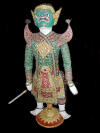
kumphan (กุมภัณฑ์)
Thai. A devil, demon, giant or
monster.


Kunti (कुंती)
Daughter of Shura and mother of
the Kauravas. She is an important figure in the epic poem Mahabharata.
Previously she was named Pritha.

Kurma (कूर्म)
Sanskrit. 'Turtle' or
'tortoise'. The second avatar of Vishnu who supported the churning stick
during the churning of the Ocean of Milk, thus preventing it from going
in the soft soil. It thus became a symbol of stability. Also transcribed
Kuurma.

Kuru
(कुरु)
A king of the Lunar race, who
ruled over Kurukshetra, a region near Delhi in northwestern India, that
was supposedly the battle scene of the war between his descendants the
Kauravas and the Pandavas, described in the epic poem Mahabharata.

Kusa
(कुश)
One of Sita's two twin sons in
the Ramayana, neither of whom were recognized by their father Rama until
they were fifteen years old. The other son was Lava. Also spelled Kusha.

Kuvalayapida
Demon in the form of an
elephant, who was sent out by Kansa to kill Krishna, his nephew.
 |